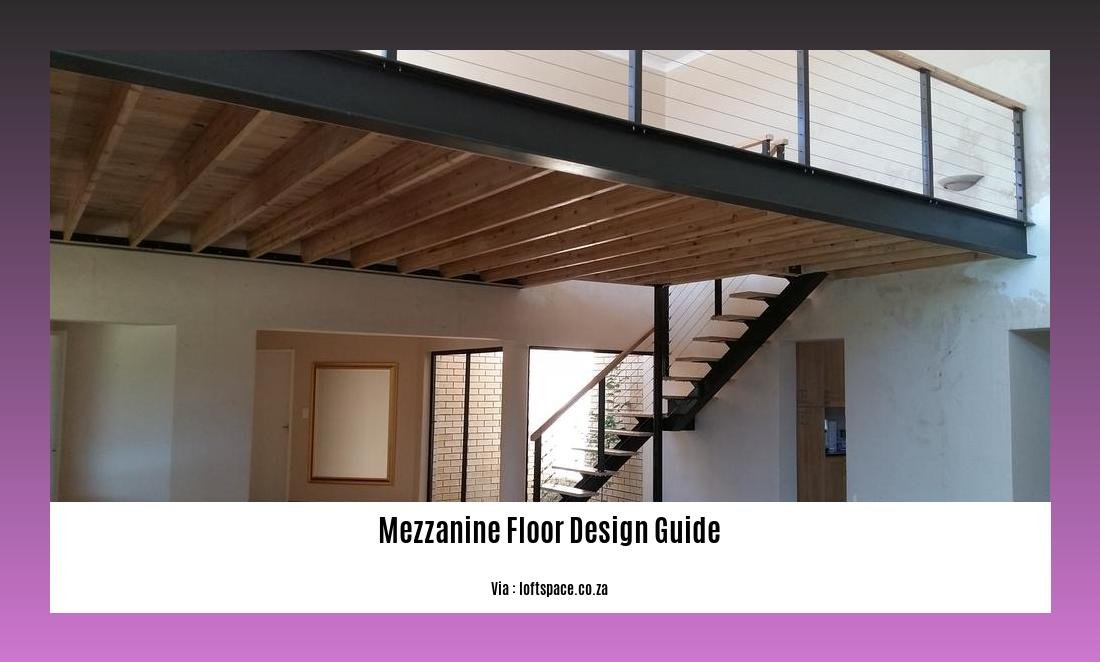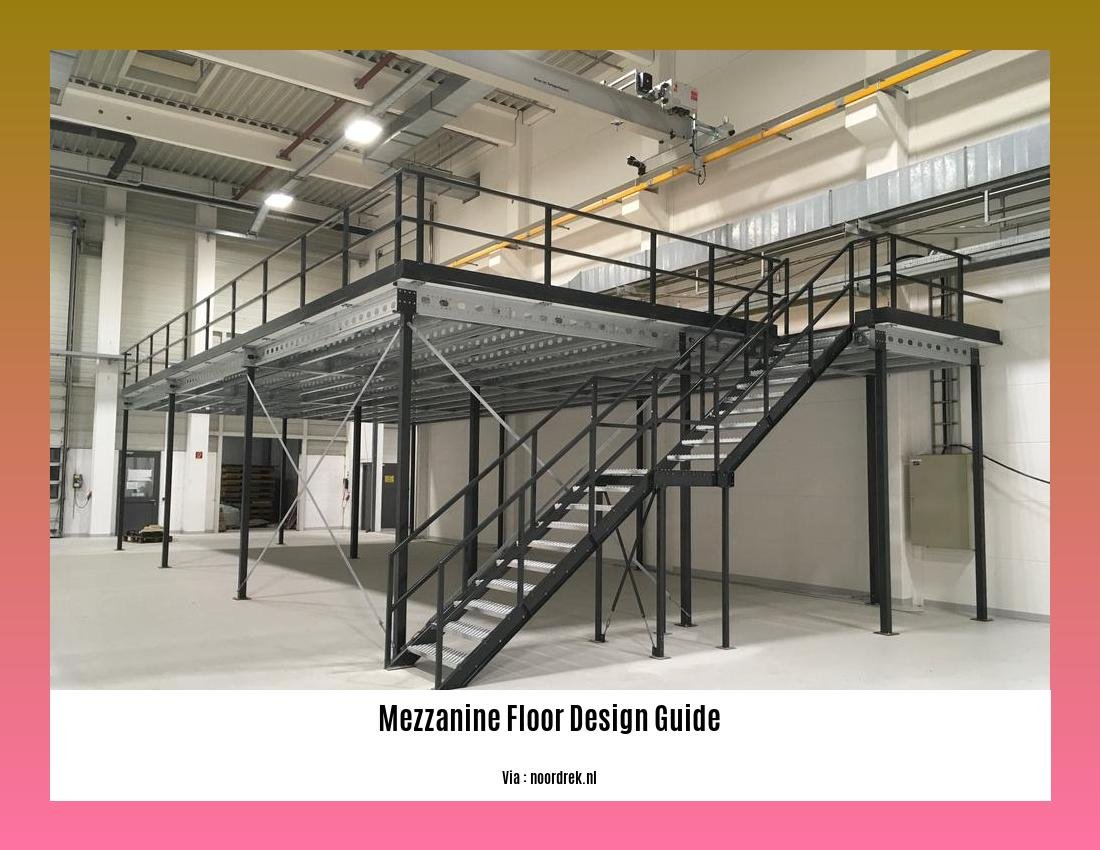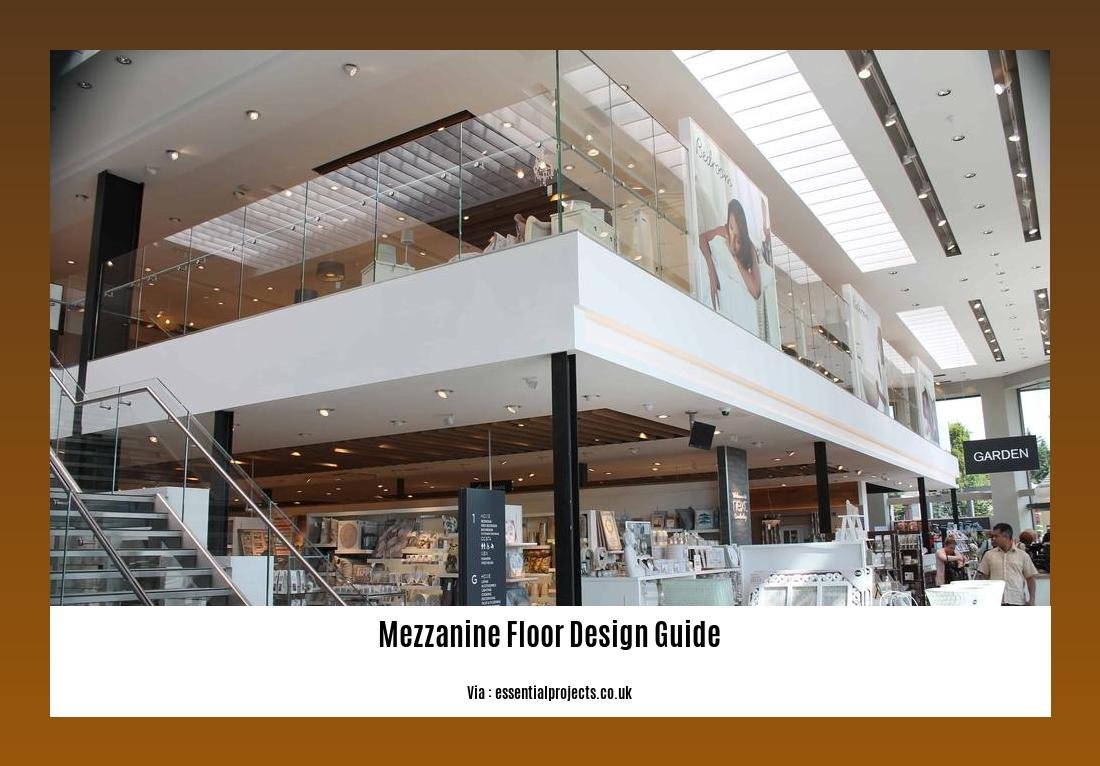Welcome to the Expert’s Mezzanine Floor Design Guide: Optimizing Space and Safety. In this comprehensive guide, we will explore the art and science of designing mezzanine floors for commercial and industrial spaces. With a focus on optimizing both space utilization and safety measures, we will delve into the key considerations, industry standards, and innovative design solutions that can transform your space into a functional and efficient environment. Whether you are an architect, a contractor, or a business owner, this guide will provide you with the knowledge and insights needed to successfully navigate the complexities of mezzanine floor design.
Key Takeaways:
- MiTek Mezzanine Systems specializes in designing and constructing mezzanine floors for various applications and spaces, offering different design styles to accommodate different construction types.
- There are two main approaches to mezzanine floor design: in-plane design and joist over bearer design. In-plane design takes up less height but can be more expensive, while joist over bearer design results in a higher floor.
- Mezzanine floors can add both space and interest to open-plan interiors, creating an intermediate level that overlooks the space below.
- When selecting a mezzanine level, it is important to consider the maximum height and clearance required, including the desired headroom above and below the floor and the thickness of the steel frame.
- MiTek Mezzanine Systems provides a range of resources on their website, including white papers and a video gallery, for more information and case studies on mezzanine floor designs.
Mezzanine Floor Design Guide

Are you looking to optimize space in your commercial or industrial space? A mezzanine floor could be the perfect solution for you. In this guide, we will explore the ins and outs of mezzanine floor design and how to maximize space while ensuring safety.
Selecting the Right Design Style
When it comes to mezzanine floor design, there are several styles to choose from. Two common approaches are in-plane design and joist over bearer design. The in-plane design involves placing the joists in the same horizontal plane as the bearers, which takes up less height but can be more expensive. On the other hand, the joist over bearer design places the joists above the bearers, resulting in a higher floor.
Consider the specific needs of your space and your budget when selecting the design style that best suits your requirements. Keep in mind factors such as available height, cost, and desired aesthetic.
Maximizing Space Utilization
A key advantage of mezzanine floors is their ability to optimize space utilization. By adding an intermediate level, you can create extra usable space without expanding the footprint of your building. To make the most of this additional space, it’s crucial to carefully plan the layout and functionalities of the mezzanine floor.
Consider the specific activities that will take place on the mezzanine. Will it be used for storage, office space, or manufacturing? This will influence decisions regarding weight capacity, access points, and overall design.
Ensuring Safety Measures
When designing a mezzanine floor, safety should be a top priority. It’s essential to comply with building codes and regulations to ensure the protection of occupants and the structural integrity of the floor. Engaging the services of an experienced architect or structural engineer will help you navigate these requirements.
Factors to consider for safety include the thickness of the steel frame, the maximum height and clearance required, and the desired headroom above and below the floor. Consult the appropriate guidelines and authorities to ensure your mezzanine floor design meets safety standards.
Pros and Cons of Mezzanine Floors
Like any design solution, mezzanine floors have their pros and cons. Let’s take a closer look:
Pros:
- Maximizes available vertical space without expanding the building’s footprint.
- Provides extra space for various purposes, such as storage or office facilities.
- Customizable and adaptable to specific needs and requirements.
- Adds visual interest and architectural appeal to the space.
- Can be quickly installed and easily modified or relocated.
Cons:
- May require additional investment due to structural requirements.
- Could affect the lighting and HVAC systems of the lower level.
- May create noise and vibration concerns, which need to be managed.
- Ongoing maintenance and inspections may be necessary to ensure safety and compliance.
Conclusion
Mezzanine floors offer a versatile and efficient solution for maximizing space in commercial and industrial settings. By carefully considering design styles, maximizing space utilization, and prioritizing safety measures, you can create a functional and visually appealing mezzanine floor that optimizes your available space.
Remember to consult with experienced architects or structural engineers and familiarize yourself with building codes and regulations to ensure your mezzanine floor design is both safe and compliant. So why wait? Start exploring the possibilities of mezzanine floor designs today!
Table:
| Design Style | Pros | Cons |
| ————- |:————-:| —–:|
| In-Plane Design | – Takes up less height | – Can be more expensive |
| Joist Over Bearer Design | – Results in a higher floor | – Requires additional structural requirements |
Note: The information provided in this table is for illustrative purposes only and should be thoroughly evaluated based on project-specific requirements.
If you’re trying to understand the difference between mezzanine debt and senior debt, check out our article on Mezzanine debt vs senior debt for a clear explanation.
If you’re looking for information on the comparison between mezzanine financing and preferred equity, our detailed guide on Mezzanine financing vs preferred equity is a must-read.
Designing a mezzanine floor and need help with calculations? Our comprehensive article on Mezzanine floor design calculations has got you covered.
For those who prefer a PDF format, download our informative guide on Mezzanine floor design calculations PDF to access the relevant calculations and insights offline.
Considering Space Utilization and Layout Optimization

Mezzanine floors have become a popular choice for homeowners and businesses looking to maximize space utilization and optimize their layouts. By creating an additional usable space within existing buildings, mezzanine floors offer a versatile and cost-effective solution.
When designing a mezzanine floor, it’s essential to consider the specific needs of the space and determine the most suitable design style. There are different design styles available, including in-plane design and joist over bearer design. While in-plane design takes up less height and can be more expensive, joist over bearer design results in a higher floor. The choice of design should align with both the desired layout and budget constraints.
To ensure the successful implementation of a mezzanine floor, careful planning of the layout and functionalities is crucial. Consideration should be given to the placement and integration of the mezzanine with the space below. For example, if office space is required underneath the mezzanine, the columns supporting the structure should be strategically placed to seamlessly integrate with the ground floor office layout.
Accurate measurement of the internal space is another critical aspect of mezzanine floor design. Before ordering materials, it is important to measure the space accurately to ensure a precise layout and proper integration with the existing area. Determining the maximum height and clearance of the mezzanine is also essential to provide sufficient headroom and consider the thickness of the steel frame supporting the structure.
Key Takeaways:
- Mezzanine floors provide an efficient way to maximize space utilization in both residential and commercial settings.
- The choice of design style, such as in-plane design or joist over bearer design, should align with the desired layout and budget.
- Careful planning of the layout and integration with the space below is crucial for optimizing the functionality of the mezzanine floor.
- Accurate measurement of the internal space and consideration of height and clearance are necessary for a successful mezzanine floor design.
Sources:
1. MiTek Mezzanine Systems. “Mezzanine Floor Design Guide.” Website
2. Excalibur Steel Buildings. “How to Build a Mezzanine Floor – Mezzanine Floors Made Easy.” Website
Complying with Building Codes and Regulations
Mezzanine floors offer a versatile solution for maximizing space utilization in both residential and commercial settings. However, it is essential to comply with building codes and regulations to ensure safety and functionality. In this guide, we will explore the key considerations for complying with building codes and regulations when designing mezzanine floors.
Load Capacity Requirements and Structural Materials
Compliance with building regulations regarding load capacity requirements and structural materials is crucial for the safety and stability of mezzanine floors. Building codes typically outline factors such as floor loading and deflection. One important code, the International Building Code (IBC), specifies that a mezzanine floor must have a minimum of one-third of the floor space of the floor below it. It also states that the sum of mezzanine floor areas should not exceed one-third of the total floor space below when multiple mezzanine floors are present.[^1]
Fire Safety and Accessibility
Building codes and standards prioritize fire safety and accessibility for mezzanine floors. To comply with regulations, it is necessary to install fire-resistant materials, fire detection and suppression systems, and emergency exits. The design should also consider proper stairways, handrails, and clear pathways for easy evacuation in case of emergencies.[^1]
Lighting Requirements
Sufficient lighting is essential for the safety and functionality of mezzanine floors. Building regulations specify the minimum lighting levels required to ensure visibility and prevent accidents. To adhere to these regulations, it is necessary to install proper lighting fixtures and emergency lighting systems.[^1]
Compliance with Australian Standards
In Australia, compliance with Australian standards is crucial for the safety and functionality of mezzanine floors. Understanding load capacity requirements, following building codes and standards, prioritizing fire safety and accessibility, considering proper lighting, and complying with other specific regulations are all essential. Working with experienced professionals can help ensure compliance and the successful implementation of mezzanine floor projects.[^2]
Mezzanine Floor Code Requirements in the United States
For mezzanine floors in the United States, compliance with building codes and regulations set by organizations such as the Occupational Safety and Health Administration (OSHA) and the International Building Code (IBC) is necessary. Additionally, each state may have its own specific set of requirements for mezzanine floors. Adhering to these codes and regulations ensures the safety and structural integrity of mezzanine floor installations.[^3]
Key Takeaways:
- Compliance with building codes and regulations is essential for the safety and functionality of mezzanine floors.
- Load capacity requirements and structural materials must be in accordance with building codes.
- Fire safety measures, including fire-resistant materials, detection systems, and emergency exits, are necessary for compliance.
- Proper lighting levels and installations are important for visibility and safety.
- Compliance with Australian standards or specific regulations in the United States, such as those established by OSHA and IBC, is crucial for mezzanine floor projects.[^1][^2][^3]
Sources:
– Avantauk: Building Regulations for Mezzanine Floors
– Mezz Floors UK: Understanding Mezzanine Floor Regulations
Selecting Appropriate Materials and Finishes for Mezzanine Construction
Mezzanine floors offer a versatile and efficient solution for optimizing space in commercial and industrial settings. When designing a mezzanine floor, selecting the appropriate materials and finishes is crucial for ensuring durability, safety, and aesthetics. In this guide, we will explore key considerations and best practices for choosing the right materials and finishes for mezzanine construction.
1. Structural Stability and Load-Bearing Capacity
The materials used for mezzanine floors must have the necessary structural stability and load-bearing capacity to support the intended use. Steel roof deck, which is the most common option, provides excellent strength and durability. It is essential to consult with experienced architects or structural engineers to determine the appropriate material based on the expected loads and requirements.
2. Fire Resistance and Safety Compliance
Compliance with fire safety regulations is paramount when selecting materials for mezzanine construction. Fire-resistant materials, such as fire-rated steel or composite panels, can help minimize the spread of flames in case of a fire. It is essential to ensure that the chosen materials meet the required fire resistance rating and are approved by local building codes and regulations.
3. Durability and Maintenance
Choosing materials that are durable and require minimal maintenance is essential for long-term performance and cost-effectiveness. Materials such as galvanized steel or aluminum are known for their corrosion resistance and longevity. Additionally, considering finishes that are easy to clean and maintain can help prolong the lifespan of the mezzanine floor.
4. Aesthetics and Design Flexibility
The materials and finishes selected for mezzanine construction can significantly impact the overall aesthetics of the space. Depending on the design intent, options such as powder-coated steel or timber decking can add a touch of sophistication and enhance the visual appeal. It is important to consider the existing interior design and branding when selecting materials and finishes.
5. Acoustic Performance
In some cases, acoustic performance may be a crucial factor in mezzanine floor design. If the space underneath requires sound isolation or noise reduction, choosing materials with good acoustic properties, such as composite panels with soundproofing capabilities, can be beneficial. It is important to assess the specific needs of the space and consult with acoustic professionals if necessary.
Key Takeaways:
- Select materials with sufficient structural stability and load-bearing capacity for the intended use of the mezzanine floor.
- Ensure compliance with fire safety regulations and choose fire-resistant materials.
- Consider durability and maintenance requirements when selecting materials and finishes.
- Take into account aesthetics and design flexibility to create visually appealing spaces.
- Assess the need for acoustic performance and choose materials accordingly.
Sources:
- MiTek Mezzanine Systems. “Mezzanine Floor Design Guide.” Website
- Lynch, Richard. “Mezzanine Floors: A Complete Guide.” Archinect
FAQ
Q1: What are the different design styles available for mezzanine floors?
A1: Mezzanine floors are available in a variety of design styles to accommodate different construction types and spaces. Some common design styles include freestanding mezzanines and rack-supported mezzanines.
Q2: How do I decide on the design style for my mezzanine floor?
A2: The choice of design for a mezzanine floor depends on the specific application and characteristics of the available space. Factors to consider include the intended use, space requirements, and overall layout goals.
Q3: Where can I find resources on mezzanine floor design styles and considerations?
A3: MiTek Mezzanine Systems provides a comprehensive Mezzanine Floor Design Guide on their website, which offers information on different design styles and considerations. Additionally, Excalibur Steel Buildings offers a guide on how to build a mezzanine floor, explaining different design approaches.
Q4: What are the key factors to consider when designing a mezzanine floor?
A4: When designing a mezzanine floor, it is important to consider factors such as the placement and layout of the space below, maximum height and clearance requirements, and the thickness of the steel frame supporting the structure.
Q5: Are there any building regulations I need to comply with when installing a mezzanine floor?
A5: Yes, compliance with building regulations is crucial to ensure the safety and functionality of mezzanine floors. These regulations may vary depending on the location, but they typically include requirements related to load capacity, fire safety, accessibility, and lighting.










